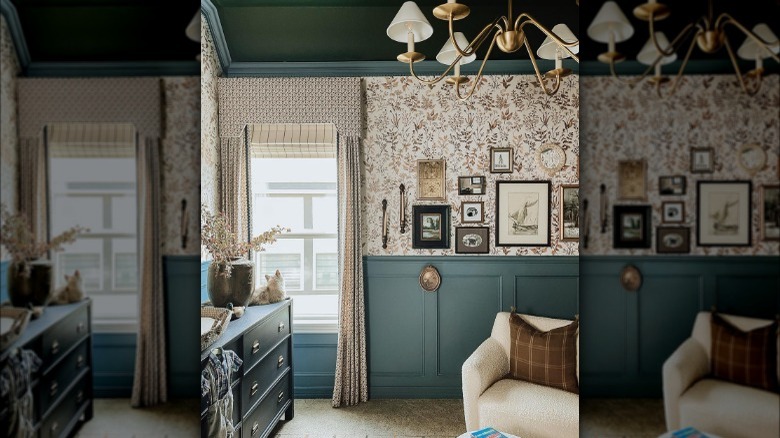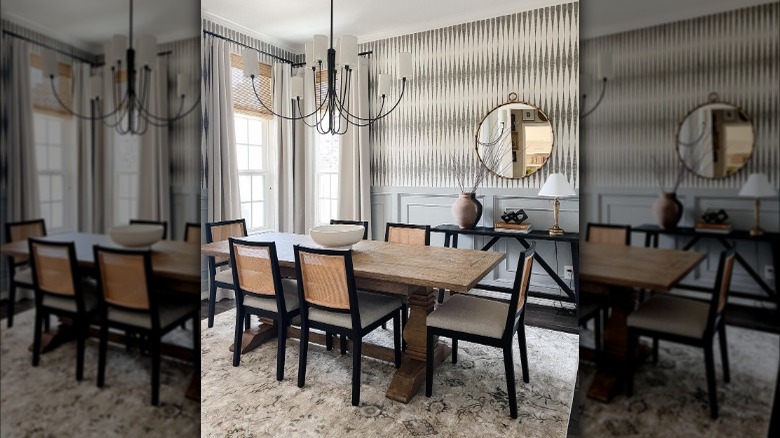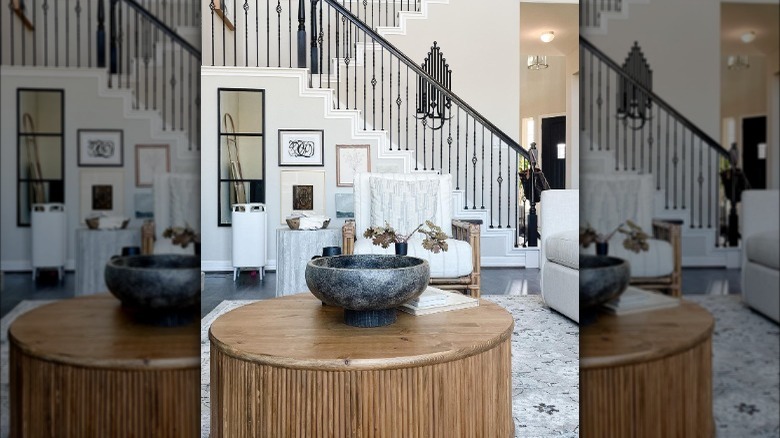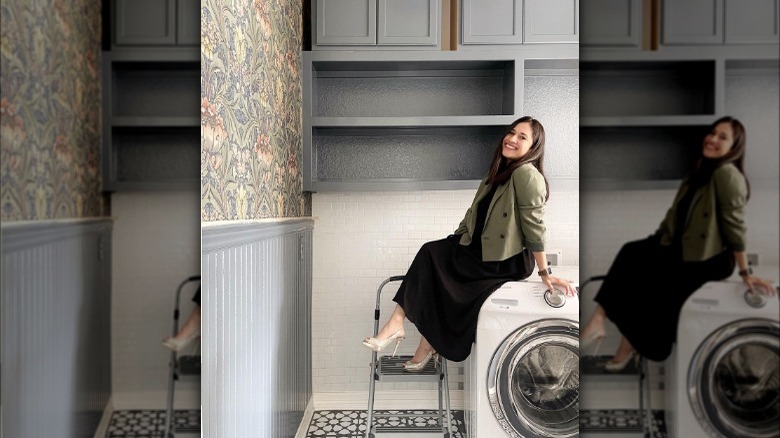Problem Spaces' Fariha Nasir On Creating Beauty In Challenging Rooms - Exclusive Interview
Every home has its quirks and unique features. Sometimes homeowners embrace them, and other times, they're stumped on how to make them work for their lifestyle and decor. It can be frustrating trying to see the beauty in these spaces, but Fariha Nasir wants homeowners to see spaces that may be challenging as a way to get creative and an opportunity to make a room that's customized to their needs.
Nasir is self-taught when it comes to home renovation, which has given her a unique perspective on designing homes. Tackling her own renovation was a practice of trying new approaches, learning new techniques, and doing it all in a budget-friendly way.
On Magnolia Network's "Problem Spaces," she strives to show homeowners that unique rooms are an opportunity more than a hindrance. In an exclusive interview with House Digest, Fariha Nasir speaks about the challenges and triumphs of renovation and how she approaches designing an interesting room.
Her love of DIY started close to home
You started off as a blogger. You wrote Pennies for a Fortune, documenting how you renovated your personal builder-grade home. Can you tell me what the process was like for you?
We bought this house about three years ago, and it was a builder-grade house. I had never worked with power tools before. I did not know what I was doing, but I saw other women DIYing and using power tools on Instagram and social media in general. I knew I wanted a beautiful custom home, but I didn't have the budget to hire out all these projects, so I decided to take things into my own hands. I taught myself how to use power tools [and] do simple projects around the house to get that high-end designer look that cost a lot of money.
I took the leap [and] bought my first tool, which was a miter saw, and it was actually a pretty scary tool to start off with. It sat in my garage for about a month until I asked my husband to set it up finally and try it out so that I could see and then try it out after he had done it. I have this video of myself using it for the first time, and it was terrifying. I don't recommend starting off with scary tools.
With that and a brad nailer, I did my first project, which was the laundry room. I built a custom cover for the washer and dryer, like a tabletop situation, and painted the floors using a stencil. That started off the journey for me. I put that first picture of our house on Instagram, and I had no intentions of turning this into a career. It happened organically. I realized that I really, really enjoyed doing projects and solving problems and turning my house into my custom dream home and then giving inspiration to other people to do the same.
Can you tell me about some of the challenges that you faced while you were renovating the home?
Teaching myself how to do woodworking was one of the biggest challenges. I'm still not an expert by any means at woodworking. All of the measurements and being really precise — it still is one of the challenges that I face. Then being a mom and having ... When I started, my elder son was 3 years old, I believe. Having him and juggling being a stay-at-home mom and doing projects was a challenge for sure. More recently, I had a baby who is now 8 months old almost, so that, again, is very difficult, juggling different roles at the same time.
Fariha Nasir believes anyone can customize their home themselves
Can you tell me about the most valuable thing you learned while doing the DIY renovation?
One of the most valuable things that I've learned is to be slow and steady, take on smaller projects in the beginning, and measure twice or thrice. [For] every measurement, I would measure and then remeasure because measurements being off can make such a big difference and it can add so much time to projects. [You need to be] accurate with your prep work, making sure you prep everything beforehand, and walk through in your head what the project will look like so that you don't run into surprises when you're doing something.
Do you have any advice for people who want to start adding custom touches to their homes?
Paint and trim work [are] great place[s] to start. That's how I started. Paint can be so transformative. It's easy; it's accessible. You don't need a skill to start adding paint to walls. Paint can be used in such different and fun ways that it can be a very big design statement, and there are ideas out there. Even in the show, I use paint in a way that's very transformative. That's a great place to start.
Trim work is another easy way. You don't need to have a ton of tools to do trim work. You probably just need a brad nailer. You don't even need a miter saw. You could use miter shears, which [are] a handheld tool. It's not scary, and adding a little bit of molding to a wall can add a lot of character.
Unique rooms are a challenge and opportunity
You have the show "Problem Spaces" now on Magnolia Network, and you tackle some very uniquely shaped rooms. How do you develop a strategy for those spaces that aren't typical square or rectangular shapes?
Letting the space guide the design is a very important thing. Walking into a space, seeing what the homeowners want out of it, and then letting the shape and the light and the size of the room direct the rest of the decisions is really important.
For example, I had a round room, a turret room, that I did for the show, and it could have been anything. It could have been turned into a little lounge area. It could have been turned into a cute little playroom. But the homeowners needed an office. And a square or rectangular desk, a traditionally shaped desk, would have been odd in that room. It would have taken up too much space and wouldn't have necessarily been the best use of space. So letting the shape of the room guide the design and [letting] the uniqueness of each room lead the next design's decisions is the best way to start off.
Have you found during your renovations any features — slope ceilings, lots of windows — that limit the renovation?
Yes. Architectural issues are often what scare homeowners, and then they can't figure out how to design around them. The best way is to design with those architectural spaces in mind and not necessarily fight those angles or those odd windows. Try to include them in your design to make them look intentional.
For example, sloped ceilings can often look like a problem or an afterthought or something that's not intentional, but highlighting it or using paneling to make it look like it's part of the design makes it look like a complete, functional space. And utiliz[e] trim work, [considering] the scale of drapery or the kind of drapery that you use. Roman shades can be really inclusive for all shapes of windows because they can be customized to any window's shape. Keeping those things in mind can help solve those problems.
What was the most difficult room that you undertook this season?
That is interesting — the most difficult room. Definitely, the rounded, turret room was a tricky one, and it was also the most fun to design.
One of the other most difficult spaces was this really small nook under the stairs. There was a desk space, a workspace for a young, 7-year-old boy. It was originally a bar area, a wet bar, and there was so little room to work with to get everything that the child needed. It was a challenge to fit everything in a small space. In that tiny of a space, there's very little room to even stand. [I had] to make it functional and usable for the boy in a way that it can [stand] the test of time, where it can grow with him and be useful not only when he is young right now [but also] when he's older. That was one of the most challenging spaces.
Function and aesthetic can coexist
Rooms have to perform double duty sometimes. You tackle an office-and-gym combination on "Problem Spaces." Do you have any advice for balancing a room's functional needs and aesthetic?
I see that so often now with people working from home more often — rooms having to perform multiple functions. In the show, we have a home office which is also a home gym and a space that's a walk-through of sorts. Keeping the rest of the design of the house in mind is really important because, especially if it's an open space, [you have to make] sure that that room doesn't clash with the rest of the house, the design flows together, and to minimize clutter and unsightly objects like gym equipment, [which] isn't necessarily the prettiest to look at.
Figur[e] out ways to conceal things that aren't pleasing to the eye and mak[e] them appear beautiful from the outside. And hav[e] things be dual purpose, like the cabinet, for example, that hides the bike in the office. It's something that's functional, but it still works as a home office and it also functions just as well as a gym when the homeowner needs to get their exercise in.
Do you have advice for people who have challenging spaces and are trying to embrace them?
A lot of people think open shelving is a great way to use wall space, but in the case of a multipurpose room, where you have kids' toys and you have office supplies and you still want it to look presentable and beautiful, cabinets that are not glass, cabinets that you can hide things in using baskets or bins and containers that eliminate that visual clutter [are] a great way to maximize functionality in a space and still have it look beautiful. Instead of putting toys or office supplies out in the open on open shelving or [in] a glass cabinet, homeowners can try using cabinets with a shutoff cabinet, like a traditional cabinet, or baskets that have tops or cubbies that can organize and declutter at the same time.
What are you excited for fans to see on this upcoming season?
I'm excited for people to see how unique places and problems can be solved with minimal time and budget, because most of the makeovers in the season are budget-friendly; nothing is too expensive. There's a lot of DIY projects, and I hope that people can be inspired to try their own little DIY projects at home.
"Problem Spaces" premieres on Magnolia Network on January 21 at 1 p.m. ET.
This interview has been edited for clarity.




